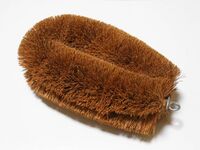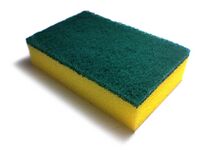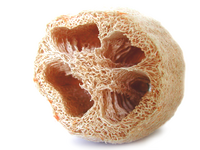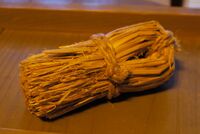Tawashi
Topic: Engineering
 From HandWiki - Reading time: 2 min
From HandWiki - Reading time: 2 min
Short description: Japanese scrubbing brush
A tawashi (たわし or 束子, lit., a bundle) is a scrubbing brush for wet cleaning,[1] of a style that is popular in Japan .[2][3] Traditionally, tawashis were made from the hemp palm.[4][5] In Japan, sponges used for rubbing and washing are now treated as forms of tawashi.
A metallic tawashi (金属たわし kinzoku tawashi) is made of metal; steel, stainless steel, and brass are frequent choices. They may be used in removing scorching and rust.
Types
Several synthetic polymers are frequently seen:
- A polyurethane sponge is sometimes called sponge tawashi (スポンジたわし suponji tawashi).
- Nylon sponges, sometimes called nylon tawashi (ナイロンたわし nairon tawashi), are suitable for washing tough stains, but should not be used on delicate items.
- An acrylic tawashi (アクリルたわし akuriru tawashi) is made of acrylic, typically knitted or crocheted.
- A luffa sponge, or luffa tawashi (ヘチマたわし hechima tawashi), is used as a body scrub.
- In recent times, some tawashis are crocheted from cotton yarn, producing the eco-friendly tawashi (エコたわし eko tawashi), which is scratch-free, and used for dishes and small cleaning jobs. (The prefix eco- (エコ) indicates that it creates less pollution because{{Vague|date=July 2017| soap or detergents.[6])
See also
References
- ↑ Sheets, Cassie. "3 reasons you should buy these Japanese scrub brushes" (in en). https://missoulian.com/lifestyles/home-and-garden/3-reasons-you-should-buy-these-japanese-scrub-brushes/article_a2c0e677-53c9-5be0-8ddb-15f14042bc78.html.
- ↑ Stinchecum, Amanda Mayer (April 5, 1987). "Shopper's World: Kyoto's Handmade Brushes". New York Times: p. A6.
- ↑ "Simple Clean Washing". https://www.simplecleanllcpowerwashing.com/.
- ↑ Oda, Shuko (June 19, 2018). "Tawashi Brush: I'd Be Lost Without My...". Financial Times: p. 57.
- ↑ Writer, JENNIFER KOPF | Staff. "Kitchen Essential: tawashi brush" (in en). https://lancasteronline.com/features/food/kitchen-essential-tawashi-brush/article_c176b502-960f-11e6-9834-e33a53116d0b.html.
- ↑ Ogawa, N. (September 9, 2009). "Magically Clean Eco Tawashi". Make 9: 114. http://makezine.com/craft/how-to_magically_clean_eco_taw/.
 |
Licensed under CC BY-SA 3.0 | Source: https://handwiki.org/wiki/Engineering:Tawashi5 views | Status: cached on September 08 2024 00:12:32↧ Download this article as ZWI file
 KSF
KSF




